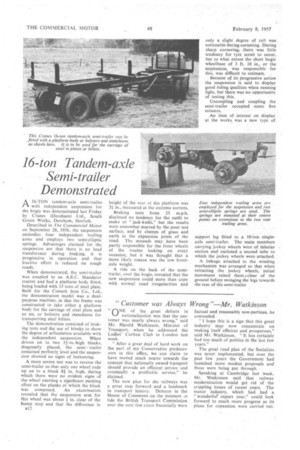16-ton Tandem-axle Semi-trailer Demonstrated
Page 46

If you've noticed an error in this article please click here to report it so we can fix it.
A16-TON tandem-axle semi-trailer with independent suspension for the bogie was demonstrated last Friday by Cranes (Dereham) Ltd., South Green Works, Dereham, Norfolk.
Described in The Commercial Motor on September 28, 1956, the suspension embodies four independent trailing arms and employs two semi-elliptic springs. Advantages claimed for the suspension are that there is no load transference during braking, it is progressive in operation and that tractive effort is reduced on rough roads.
When demonstrated, the semi-trailer was coupled to an A.E.C. Mandator tractor and had a platform body fitted, being loaded with 15 tons of steel plate. Built for the Consett Iron Co., Ltd., the demonstration model was a dualpurpose machine, in that the frame was constructed to take either a platform body for the carriage of steel plate and so on, or bolsters and stanchions for transporting steel billets.
The demonstration consisted of braking tests and the use of blocks to show the degree of articulation available with the independent suspension. When driven on to two 54--in.-high blocks, diagonally placed, the semi trailer remained perfectly level and the suspension showed no signs of bottoming.
A more severe test was to reverse the semi-trailer so that only one wheel rode up on to a block 81 in. high, during which there were no evident signs of the wheel exerting a significant pushing effect on the planks of which the block was composed. An examination revealed that the suspension arm for this wheel was about in. clear of the bump stop and that the difference in
al 2
height of the rear of the platform was 3re in., measured at the extreme corners.
Braking tests from 25 m.p.h. disclosed no tendency for the outfit to snake or " jack-knife," but the results were somewhat marred by the poor test surface, and by clumps of grass and earth in the expansion joints of the road. The mounds may have been partly responsible for the front wheels of the tractor locking on every occasion, but it was thought that a more likely reason was the low frontaxle weight.
A ride on the back of the semitrailer, over the bogie, revealed that the new suspension could more than cope with normal road irregularities and only a slight degree of roll was noticeable during cornering. During sharp cornering, there was little tendency for tyre scrub to occur, but to what extent the short bogie wheelbase of 3 ft. 10 in., or the suspension, was responsible for this, was difficult to estimate.
Because of its progressive action the suspension is said to display good riding qualities when running light, but there was no opportunity of testing this.
Uncoupling and coupling the semi-trailer occupied some five minutes.
An item of interest on display at the works was a new type of
support leg fitted to a 10-ton singleaxle semi-trailer. The main members carrying jockey wheels were of tubular section and enclosed a second tube to which the jockey wheels were attached.
A linkage attached to the winding mechanism was arranged so that when retracting the jockey wheels, initial movement raised them ..clear of the ground before swinging the legs towards the rear of the semi-trailer




































































































